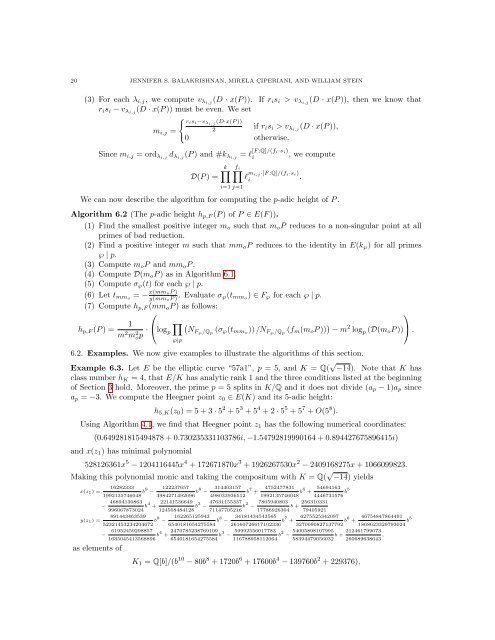p-ADIC HEIGHTS OF HEEGNER POINTS AND ANTICYCLOTOMIC ...
p-ADIC HEIGHTS OF HEEGNER POINTS AND ANTICYCLOTOMIC ...
p-ADIC HEIGHTS OF HEEGNER POINTS AND ANTICYCLOTOMIC ...
Create successful ePaper yourself
Turn your PDF publications into a flip-book with our unique Google optimized e-Paper software.
20 JENNIFER S. BALAKRISHNAN, MIRELA ÇIPERIANI, <strong>AND</strong> WILLIAM STEIN<br />
(3) For each λi,j, we compute vλi,j (D · x(P )). If risi > vλi,j (D · x(P )), then we know that<br />
risi − vλi,j (D · x(P )) must be even. We set<br />
mi,j =<br />
risi−vλ i,j (D·x(P ))<br />
Since mi,j = ordλi,j dλi,j (P ) and #kλi,j = ℓ<br />
2 if risi > vλi,j (D · x(P )),<br />
0 otherwise.<br />
D(P ) =<br />
k fi <br />
ℓ<br />
[F :Q]/(fi·si)<br />
i<br />
mi,j·[F :Q]/(fi·si)<br />
i<br />
i=1 j=1<br />
, we compute<br />
We can now describe the algorithm for computing the p-adic height of P .<br />
Algorithm 6.2 (The p-adic height hp,F (P ) of P ∈ E(F )).<br />
(1) Find the smallest positive integer mo such that moP reduces to a non-singular point at all<br />
primes of bad reduction.<br />
(2) Find a positive integer m such that mmoP reduces to the identity in E(k℘) for all primes<br />
℘ | p.<br />
(3) Compute moP and mmoP .<br />
(4) Compute D(moP ) as in Algorithm 6.1.<br />
(5) Compute σ℘(t) for each ℘ | p.<br />
(6) Let tmmo<br />
(7) Compute hp,F (mmoP ) as follows:<br />
⎛<br />
hp,F (P ) =<br />
1 <br />
NF℘/Qp (σ℘(tmmo)) /NF℘/Qp (fm(moP )) − m 2 ⎞<br />
logp (D(moP )) ⎠ .<br />
= − x(mmoP )<br />
y(mmoP ) . Evaluate σ℘(tmmo ) ∈ F℘ for each ℘ | p.<br />
m2m2 op · ⎝logp ℘|p<br />
6.2. Examples. We now give examples to illustrate the algorithms of this section.<br />
Example 6.3. Let E be the elliptic curve “57a1”, p = 5, and K = Q( √ −14). Note that K has<br />
class number hK = 4, that E/K has analytic rank 1 and the three conditions listed at the beginning<br />
of Section 3 hold. Moreover, the prime p = 5 splits in K/Q and it does not divide (ap − 1)ap since<br />
ap = −3. We compute the Heegner point z0 ∈ E(K) and its 5-adic height:<br />
h5,K(z0) = 5 + 3 · 5 2 + 5 3 + 5 4 + 2 · 5 5 + 5 7 + O(5 8 ).<br />
Using Algorithm 4.1, we find that Heegner point z1 has the following numerical coordinates:<br />
(0.649281815494878 + 0.730235331103786i, −1.54792819990164 + 0.894427675896415i)<br />
and x(z1) has minimal polynomial<br />
528126361x 5 − 1204116445x 4 + 172671870x 3 + 1926267530x 2 − 2409168275x + 1066099823.<br />
Making this polynomial monic and taking the compositum with K = Q( √ −14) yields<br />
x(z1) =<br />
16282333<br />
1992135746048 b9 −<br />
122237657<br />
3984271492096 b8 − 314403157<br />
498033936512 b7 + 4752477831<br />
1992135746048 b6 + 54694163<br />
4446731576 b5<br />
− 46894130863<br />
996067873024 b4 + 22141536649<br />
124508484128 b3 − 47631155337<br />
71147705216 b2 − 7805940803 256310331<br />
b +<br />
17786926304 79405921<br />
891443463539<br />
y(z1) =<br />
52321453234204672 b9 −<br />
162265125943<br />
6540181654275584 b8 − 34181434543565<br />
26160726617102336 b7 + 6275525342097<br />
3270090827137792 b6 + 46754847864491<br />
1868623329793024 b5<br />
as elements of<br />
− 61952459298857<br />
1635045413568896 b4 + 2470785238769109<br />
6540181654275584 b3 − 59992556017783<br />
116788958112064 b2 − 54005898107995<br />
58394479056032<br />
.<br />
b + 212461799073<br />
260689638643 ,<br />
K1 = Q[b]/(b 10 − 80b 8 + 1720b 6 + 17600b 4 − 139760b 2 + 229376),
















